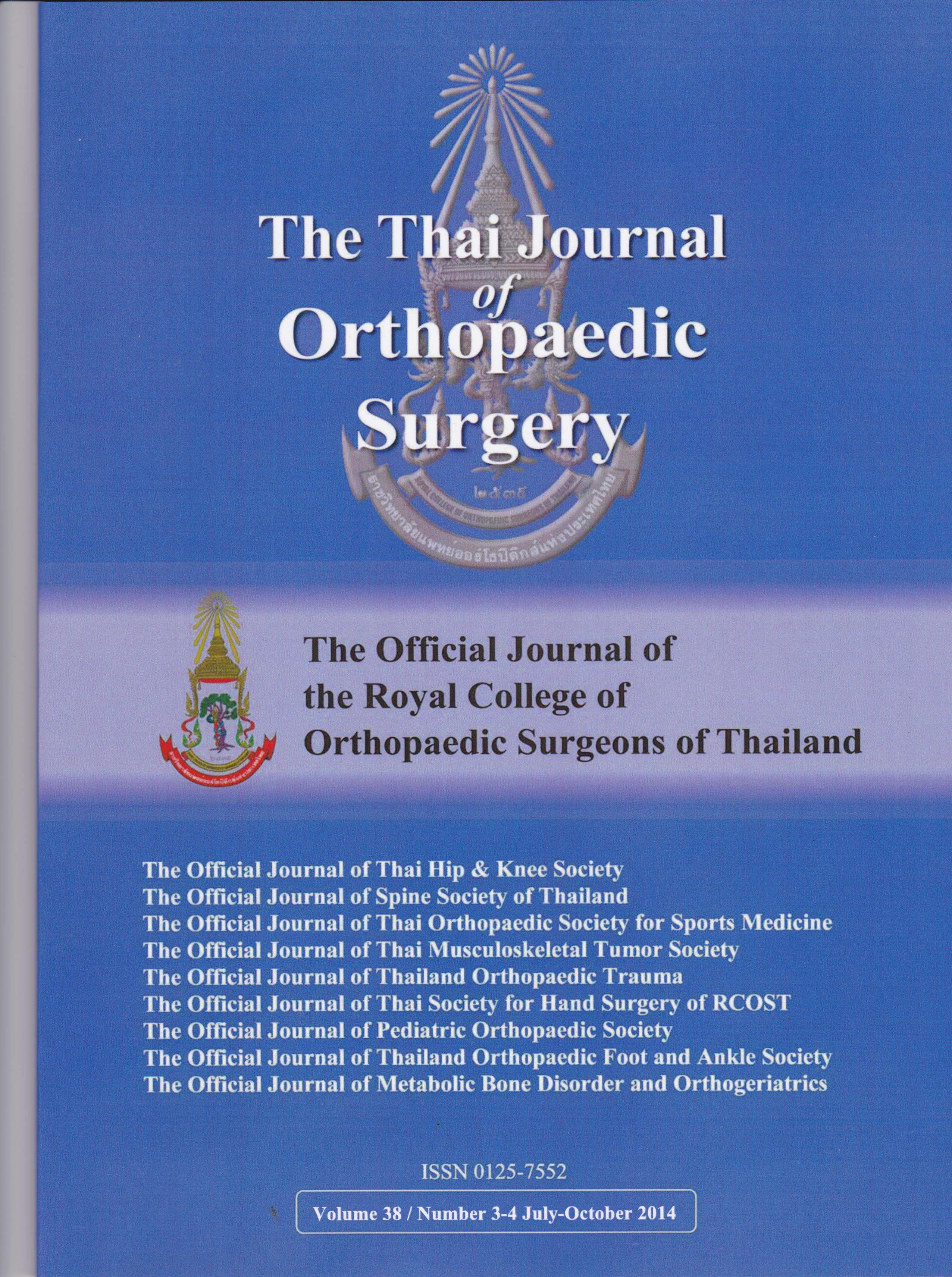Hip Arthroscopy in Traumatic Hip Dislocation: Literature review and two case reports
Main Article Content
Abstract
Hip dislocations occur commonly in young adults from high-energy motor vehicle accidents. Injuries to the hip range from simple dislocation without a fracture to complex fracture of the acetabulum or femoral head/neck. Complications after traumatic hip dislocation are devastating. This injury may lead to prolonged disability and dysfunction from complications such as osteoarthritis (OA) and osteonecrosis. Osteoarthritis after traumatic hip dislocation occurs at a frequency of 24% to 54%. There was a report that demonstrated 24% of the simple hip dislocation patients developed osteoarthritis . The development of OA after hip dislocation is considered to be caused by residual intra-articular small bone or cartilage fragments. Several patients may have loose bodies within the joint that goes unrecognized and untreated. There is a high prevalence of intra-articular loose bodies despite negative plain radiographs and thin-cut CT scans. Direct arthroscopic visualization is the best way to demonstrate the intra-articular loose bodies and debris. The main purpose of this article is to review the role of hip arthroscopy in traumatic hip dislocations and a variety of traumatic hip injuries.
Article Details
References
2. Epstein HC. Traumatic dislocation of the hip. Baltimore, MD: Williams & Wilkins, 1980.
3. Mitsionis GI, Lykissas MG, Motsis E, Mitsiou D, Gkiatas I, Xenakis TA, et al. Surgical management of posterior hip dislocations associated with posterior wall acetabular fracture: A study with a minimum follow-up of 15 years. J Orthop Trauma 2012; 26: 460-5.
4. Epstein HC. Traumatic dislocations of the hip. Clin Orthop Relat Res 1973; 92: 116-42.
5. Thompson VP, Epstein HC. Traumatic dislocation of the hip; a survey of two hundred and four cases covering a period of twenty-one years. J Bone Joint Surg Am 1951; 33: 746-78.
6. Levin PE. Hip dislocations. In: Browner BD, Jupiter JB, Levine AM, et al, eds. Skeletal Trauma. Philadelphia: WB Saunders; 1998: 1713-50.
7. Stewart MJ, McCarroll HR, Mulhollan JS. Fracture-dislocation of the hip. Acta Orthop Scand 1975; 46: 507-25.
8. Delee JC. Fractures and dislocations of the hip. In: Rockwood CA Jr, Green DP, eds. Fractures in adults. Ed 2. Philadelphia: JB Lippincott, 1984; 1211-356.
9. Letournel E. Acetabulum fractures. Clin Orthop 1980; 151: 81-106.
10. Matta JM, Anderson LM, Epstein HC. Fracture of the acetabulum. Clin Orthop 1986; 205: 230-50.
11. Rowe CR, Lowell JD. Prognosis of fractures of the acetabulum. J Bone Joint Surg Am 1961; 43: 30-59.
12. Epstein HC. Posterior fracture: dislocation of the hip. J Bone Joint Surg Am 1974; 56: 1103-27.
13. Evans CH, Mazzocchi RA, Nelson DD. Experimental arthritis induced by intraarticular injection of allogenic cartilaginous particles into rabbit knees. Arthritis Rheum 1984; 27: 200-8.
14. Armstrong JR. Traumatic dislocation of the hip joint: Review of 101 dislocations. J Bone Joint Surg Br 1948; 30: 430-45.
15. Brav CEA. Traumatic dislocation of the hip. J Bone Joint Surg Am 1962; 44: 1115-34.
16. Upadhyay SS, Moulton A, Srikrishnamurthy K. An analysis of the late effects of traumatic posterior dislocation of the hip without fracture. J Bone Joint Surg Br 1983; 65: 150-2.
17. Yamamoto Y, Ide T, Ono T, Hamada Y. Usefulness of arthroscopic surgery in hip trauma cases. Arthroscopy 2003; 19: 269-73.
18. Mullis BH, Dahners LE. Hip arthroscopy to remove loose bodies after traumatic dislocation. J Orthop Trauma 2006; 20: 22-6.
19. Philippon MJ, Kuppersmith DA, Wolff AB, Briggs KK. Arthroscopic findings following traumatic hip dislocation in 14 professional athletes. Arthroscopy 2009; 25: 169-74.
20. Ilizaliturri VM Jr, Gonzalez-Gutierrez B, Gonzalez-Ugalde H, Camacho-Galindo J. Hip arthroscopy after traumatic hip dislocation. Am J Sports Med 2011; 39(suppl 1): 50S-7S.
21. Chernchujit B, Sanguanjit P, Arunakul M, Jitapankul C, Waitayawinyu T. Arthroscopic loose body removal after hip fracture dislocation: experiences in 7 cases. J Med Assoc Thai 2009; 92(suppl 6): S161-4.
22. Park MS, Yoon SJ, Choi SM. Hip arthroscopic management for femoral head fractures and posterior acetabular wall fractures (Pipkin type IV). Arthrosc Tech 2013; 2:e221-e225.
23. Clarke MT, Arora A, Villar RN. Hip arthroscopy: complications in 1054 cases. Clin Orthop Relat Res 2003; 406: 84-8.
24. Sampson TG. Complications of hip arthroscopy. Clin Sports Med 2001; 20: 831-5.
25. Bartlett CS, DiFelice GS, Buly RL, Quinn TJ, Green DS, Helfet DL. Cardiac arrest as a result of intraabdominal extravasation of fluid during arthroscopic removal of a loose body from the hip joint of a patient with an acetabular fracture. J Orthop Trauma 1998; 12: 294-9.
26. Rosenbaum A, Roberts T, Flaherty M. Posterior dislocation of the hip following arthroscopy. Bull Hosp Jt Dis 2014; 72: 181-4.
27. Khanna V, Harris A, Farrokhyar F, Choudur HN, Wong IH. Hip arthroscopy: prevalence of intra-articular pathologic findings after traumatic injury of the hip. Arthroscopy 2014: 30; 299-304.
28. Park MS, Her IS, Cho HM, Chung YY. Internal fixation of femoral head fractures (Pipkin I) using hip arthroscopy. Knee Surg Sports Traumatol Arthrosc 2014: 22; 898-901.


